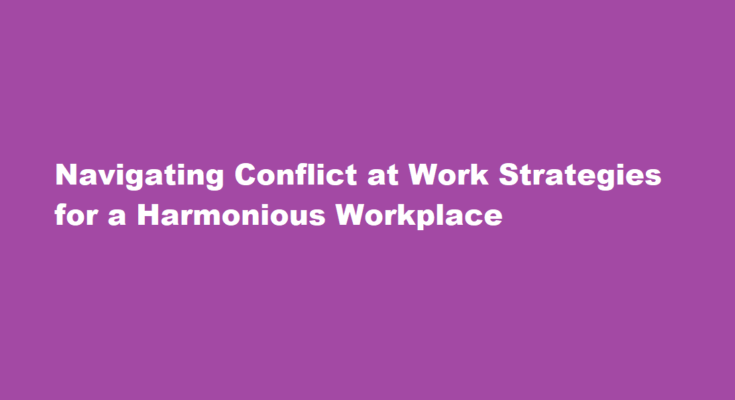Introduction
In today’s fast-paced work environment, conflicts are bound to arise as individuals with diverse personalities, perspectives, and goals collaborate to achieve common objectives. While conflicts are inevitable, how they are managed can significantly impact the overall productivity and atmosphere of the workplace. In this article, we will explore effective strategies to handle conflicts at work, fostering an environment of mutual understanding, cooperation, and growth.
Promote Open Communication
Clear and open communication is the foundation for conflict resolution. Encourage employees to express their thoughts and concerns openly, while also actively listening to their peers. Establish regular channels for feedback and ensure that everyone’s opinions are heard and valued. By creating an atmosphere of open communication, conflicts can be addressed before they escalate into major issues.
Address Conflicts Early
Procrastination in addressing conflicts can be detrimental to both individuals involved and the overall team dynamics. Encourage employees to address conflicts in their early stages, as small issues are often easier to resolve. Offer mediation and conflict resolution training to supervisors and team leaders, empowering them to facilitate discussions and find suitable solutions before conflicts become unmanageable.
Embrace a Collaborative Approach
Rather than approaching conflicts with a confrontational mindset, foster a collaborative environment where team members work together to find common ground. Encourage the use of “I” statements instead of accusatory language, promoting understanding and empathy between conflicting parties. Collaborative problem-solving can lead to innovative solutions and stronger team cohesion.
Focus on the Issue, Not the Person
In the heat of a conflict, it’s essential to remember that the problem lies with the situation and not the individuals involved. Avoid personal attacks and concentrate on the specific issue at hand. This approach helps in preventing conflicts from escalating and maintains a sense of respect and professionalism among team members.
Encourage Empathy and Perspective-Taking
Empathy is a powerful tool in resolving conflicts. Encourage team members to put themselves in each other’s shoes and try to understand the other person’s perspective. This empathetic approach can lead to better communication, increased mutual respect, and a higher likelihood of finding common ground.
Set Clear Boundaries and Expectations
Many conflicts arise due to misunderstandings or differing expectations. To avoid such situations, ensure that all team members have a clear understanding of their roles, responsibilities, and the expected outcomes. Establish boundaries for communication and behavior, and make sure they are adhered to by all team members.
Seek Third-Party Mediation
In some cases, conflicts may prove difficult to resolve internally. In such instances, consider bringing in an impartial third-party mediator to facilitate discussions and find a neutral resolution. Mediators can provide an objective perspective, helping parties move past personal biases and work towards a mutually acceptable solution.
Learn from Conflicts
Conflicts can serve as opportunities for growth and learning. Encourage employees to reflect on the underlying causes of conflicts and identify potential areas for improvement. Create a culture that embraces constructive criticism and views conflicts as learning experiences rather than as failures.
Implement Conflict Resolution Workshops
Invest in conflict resolution workshops and training for all employees. These workshops can provide valuable insights into effective communication, negotiation, and problem-solving techniques. Employees equipped with conflict resolution skills are more likely to handle disagreements professionally and constructively.
FREQUENTLY ASKED QUESTIONS
How do you handle conflict at work answers?
Aim to provide an example if possible. Example: “I actively readjust my attitude during a conflict situation. This means that I strive to listen to the other person’s point of view without becoming defensive. I also attempt to move the confrontation to a private space to avoid further complications.”
How to resolve conflict in a team?
Encourage team members to listen to one another, respect each other’s points of view, and not interrupt or make personal comments. During the conversation: Keep the tone of the conversation calm and non-threatening. Encourage active listening , so people understand where the other person is coming from.
Conclusion
In any workplace, conflicts are an inevitable part of the human dynamic. However, with a proactive and collaborative approach, conflicts can be effectively managed to promote a harmonious and productive work environment. By fostering open communication, empathy, and a focus on problem-solving, teams can resolve conflicts in a manner that benefits both individuals involved and the organization as a whole. Remember, conflict resolution is not about eliminating disagreements but transforming them into opportunities for growth and improvement. With these strategies in place, organizations can create a workplace culture that thrives on understanding, cooperation, and mutual respect.
Read Also : Mastering The Art of Sewing a Button A Step-by-Step Guide



